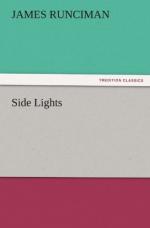is what particularly constitutes a man of the world,
and a well-bred man!” All true enough, but how
shallow, and how ineffably conceited! Here is
another absurd fragment—“My dear boy,
let us resume our reflections upon men, their character,
their manners—in a word, our reflections
upon the World.” It is quite like Mr. Pecksniff’s
finest vein. There is not a touch of nature or
vital truth in the Chesterfield letters, and the most
that can be said of them is that they are the work
of a fairly clever man who was flattered until he
lost all sense of his real size. If we take the
whole bunch of finikin sermons and compare them with
the one tremendous knock-down letter which Johnson
sent to the dandy earl, we can easily see who was
the Man of the pair. When we return to Walpole,
the case is different. Horace never posed at all;
he was a natural gentleman, and anything like want
of simplicity was odious to him. The age lives
in his charming letters; after going through them
we feel as though we had been on familiar terms with
that wicked, corrupt, outwardly delightful society
that gambled and drank, and scandalised the grave
spirits of the nation, in the days when George III.
was young. Horace Walpole was the letter-writer
of letter-writers; his gossip carries the impress
of truth with it; and, though he had no style, no
brilliancy, no very superior ability, yet, by using
his faculties in a natural way, he was able to supply
material for two of the finest literary fragments of
modern times. I take it that the most stirring
and profoundly wise piece of modern history is Carlyle’s
brief account of William Pitt, given in the “Life
of Frederick the Great.” Once we have read
it we feel as though the great commoner had stood
before us for a while under a searching light; his
figure is imprinted on the very nerves, and no man
who has read carefully can ever shake off an impression
that seems burnt into the fibre of the mind.
This superlatively fine historic portrait was painted
by Carlyle solely from Walpole’s material—for
we cannot reckon chance newspaper scraps as counting
for much—and thus the gossip of Strawberry
Hill conferred immortality on himself and on our own
Titanic statesman. But Walpole’s influence
did not end there. Whoever wants to read a very
good and charming work should not miss seeing Sir
George Trevelyan’s “Life of Charles James
Fox.” To praise this book is almost an
impertinence. I content myself with saying that
those who once taste its fascination go back to it
again and again, and usually end by placing it with
the books that are “the bosom friends”
of men. Now the grim Scotchman lit up Horace’s
letters with the lurid furnace-glow of his genius;
Sir George held the serene lamp of the scholar above
the same letters, and lo, we have two pieces that
can only die when the language dies! What a feat
for a mere letter-writer to achieve! Let ambitious
correspondents take example by Horace Walpole, and
learn that simplicity is the first, best—nay,
the only—object to be aimed at by the letter-writer.




